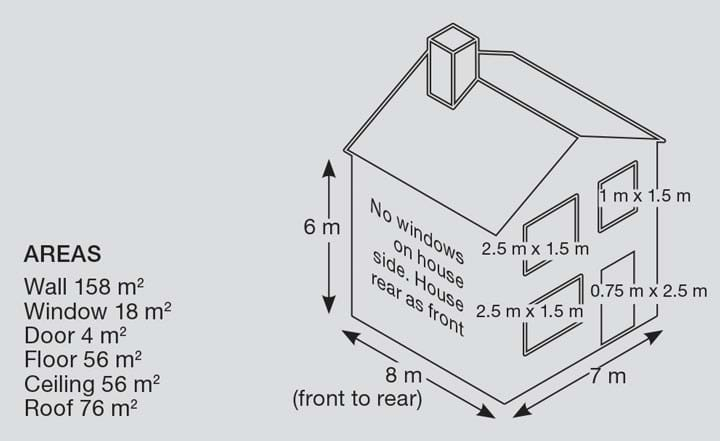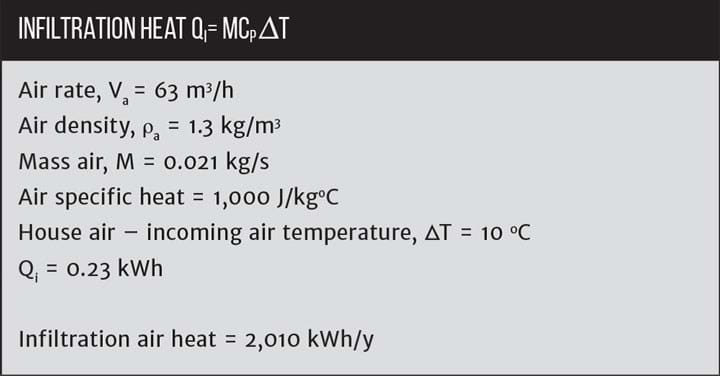The Net Zero House
Can net zero housing help the UK meet targets? Tom Baxter does the math
DIRECT CO2 emissions from residential households in 2018 were 68 million tonnes of CO2 equivalent (mtCO2e) The total across all UK sectors was 451 mtCO2e, hence our households are 15% of the UK’s carbon footprint. Households are also indirect emitters as a result of using electricity derived from fossil fuel combustion. The UK’s sector carbon footprint and specific building footprint is shown in Figure 1.
Clearly, reducing household energy consumption will have a significant impact on the UK’s carbon emissions. Furthermore, it will reduce household fuel bills.
This article sets out a standard house heated and powered by gas and electricity. An all-electric net zero house (NZH) is developed and compared with the standard house and energy savings quantified.

The standard house

Energy consumption in our houses results from heating and powering appliances. Dimensions and heat transfer areas used for this analysis are shown in Figure 2.

BUILDING FABRIC LOSSES
The largest energy requirement is for heating. Heat will be lost through walls, floor, ceiling, windows and doors. Knowing the overall heat transfer coefficient for the building fabric, the heat loss can be calculated from the familiar expression:
Heat Loss, Qloss
Qloss =∑Ui Ai ∆Ti
Where
Ui = OHTC, W/m2oC
Ai = Fabric surface area, m2
∆Ti = Inside-outside temperature difference, oC
U values are taken from UK Building Regulations (https://bit.ly/3hTw9Hi).
The average annual UK temperature is approximately 9oC (https://bit.ly/35jCgiM). Assuming the average room temperature is 19oC, heat losses are shown in Table 1.
Fabric losses are therefore 7,280 kWh/y.

BATHING/SHOWERING
In addition to fabric losses, the heat required for bathing and showering is a further energy load. According to the Energy Saving Trust (https://bit.ly/38nitB1) we take, on average, 4.4 showers and 1.3 baths every week.

Assuming the average household contains 2.3 people (https://bit.ly/2LuFl8Q), then the total heat requirement for standard house showering and bathing is 1,470 kWh/y.
AIR INFILTRATION
Heating cold infiltrated air also puts a demand on the household heating load. UK building requirements (https://bit.ly/2JR0KIG) indicate a figure of 7 m3/hm2 at 50 pa differential. A rule of thumb is divide this number by 20 (https://bit.ly/3nndZ1I) to achieve the actual house infiltration rate.
The standard house has a wall and window area of 180 m2, hence the air infiltration rate is 1,260 m3/h at 50 pa and 63 m3/h actual.

Hence total heat required for the house is the sum of fabric losses, bathing and infiltrated air heating is 10,760 kWh/y. Assuming a standard house boiler efficiency of 85%, the annual house heat consumption is 12,660 kWh/y.
ELECTRICITY
A listing of typical household electricity users (https://bit.ly/3nmbw7x) and their annual usage is shown in Table 2.

For comparison, Ofgem data (https://bit.ly/3bhsOQJ) shows that a medium house consumes 12,000 and 2,900 kWh of gas and electricity respectively per annum. So the standard house calculations of 12,660 and 2,880 kWh/y agree closely with the Ofgem numbers.
The net zero house

Recent Editions
Catch up on the latest news, views and jobs from The Chemical Engineer. Below are the four latest issues. View a wider selection of the archive from within the Magazine section of this site.




